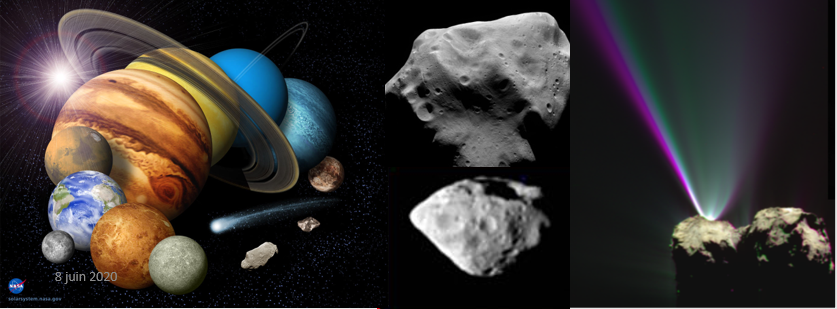
I am professor at Université Paris Cité, researcher at the Laboratoire d’Instrumentation et de Recherche en Astrophysique (LIRA, formely named LESIA), and senior member of the Institut Universitaire de France (https://www.iufrance.fr/les-membres-de-liuf/membre/2002-sonia-fornasier.html)
I am expert on spectroscopy, photometry and polarimetry of minor bodies of the Solar System (NEO, main belt asteroids, Jupiter Trojans, Centaurs, TNOs and comets). The small bodies of the Solar System represent remnants of the building blocks of the planets. As such, they are our best windows into the processes that occurred during the earliest history of the Solar System. Asteroids cast light on the planetesimal composition, on the location of the snow line, on the thermal conditions of the early Solar System, on planetary migration theories, and on the alteration processes acting on the Solar System. They also have a high exo-biological importance, because the bombardment of the planets by primitive small bodies may have enriched them in organic and volatile materials which might have favored the appearance of life.
My work is based on multi-wavelength observational campaigns from groundbased and space telescopes, on the modelling of the bodies’ physico-chemical surface composition and of their thermal properties, and on statistical analysis. I am involved in several space missions devoted to the asteroids, comets, planets and satellites investigation (Rosetta, Herschel, Spitzer, OSIRIS-REX, MMX, BEPICOLOMBO, JUICE).
PUBLICATIONS
I have published more than 290 articles in peer review journals, including about 26 articles for the prestigious reviews Science, Nature, Nature Astronomy. See the publication list: Publications List
Main experience in Space missions
- Deputy PI for the MIRS imaging-spectrometer (https://lesia.obspm.fr/Spectro-imageur-MIRS-pour-la.html) of the Japan Aerospace Exploration Agency Mars Moon Explorer mission (MMX)
- Interdisciplinary Scientist of the ESA Comet Interceptor mission, and co-chair of the Comet Environment Working group since 2025
- Interdisciplinary scientist of the Hayabusa 2R extended mission of JAXA
- Co-Investigator (Co-I) of the imaging system OSIRIS (https://www.mps.mpg.de/1979623/OSIRIS) for the Rosetta mission (ESA) which includes 2 cameras (WAC and NAC), and it is realized by a consortium of 9 institutes from 6 different countries (about 65 people between co-investigators and associated scientists), and associated scientist of the VIRTIS spectro-imager onboard Rosetta
- Responsible of the inflight radiometric calibrations of OSIRIS
- chair of the working group on the spectrophotometric properties of the 67P
- Co-I of the SIMBIO-SYS instrument for the BEPI COLOMBO (ESA, https://sci.esa.int/web/bepicolombo) mission
- Associated scientist of the OSIRIS-REX (NASA) mission (lhttps://www.asteroidmission.org/), member ofthe spectral analysis and photometry working groups
- Associated scientist of the JANUS instrument of the JUICE (ESA, https://sci.esa.int/web/juice) mission
- Chair of the working group : Remote sensing payload for the asteroid sample return mission Marco Polo-R
- Science lead for the LESIA laboratory of the MARIS instrument, and Co-I of 4 instruments (MARIS-spectrograph, Vespa- multi sensor package, MaNAC-camera, et CUC-close up camera) of the MarcoPolo-R mission ( https://www.oca.eu/fr/mission-marcopolo-r)
- Co-I of the MarcoPolo, MarcoPolo–R and MarcoPolo-M5 missions selected by ESA for assessment studies for the ESA Cosmic Vision-M2, M3, and M5 program
MAIN SERVICES TO THE COMMUNITY
- Member of the of the European Space Science Committee (ESSC https://www.essc.esf.org/) and member of the Solar System and Exploration Panel of ESSC
- Since Sept. 2025 : member of the scientific council of Paris Cité Univ. Physics department
- Since 2024: member of the French commission of specialist in Astronomy and Astrophysics (CSAA)
- Head of the Planetology team (about 45 people, one of the biggest planetology team in Europe) of the LESIA/LIRA laboratory in 2016-2024L
- Member of the Board of Directors of the Université Paris Cité (2019-2022)
- Member of the Board of Directors of the Paris Observatory (2019-2022)
- 2012-2015: member of the scientific council of the Paris Diderot University’s Physic Departmenet
- Member of the ESA
- 2012-2015 : member of the panel of experts for Physics and Astronomy for the Physic Department of the Paris Diderot University
- Member of the LESIA enlarged direction board
- Invited member of the LESIA laboratory board
- member of the 34 section (Astronomy & Astrophysics) of the French Universities National council (CNU)
- Member of the European Space Agency Planetary Science Archive User Group (PSA-UG) since 2016, and referent and contact point for issues/questions related to the small bodies of the Solar System
